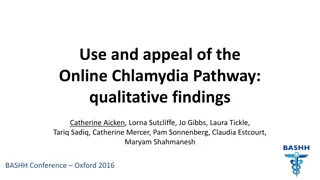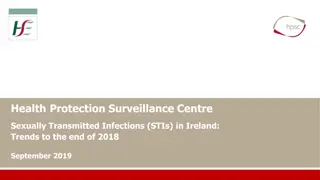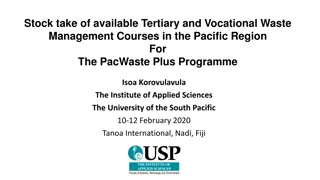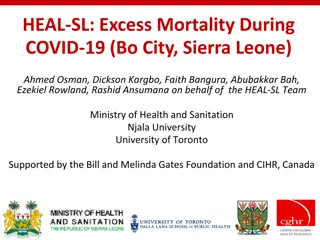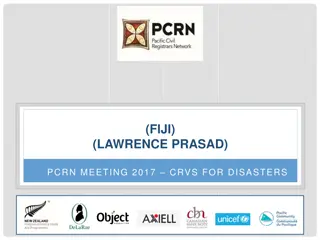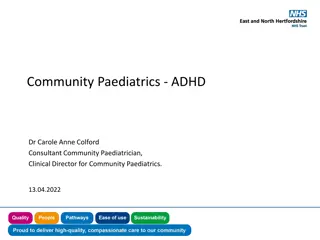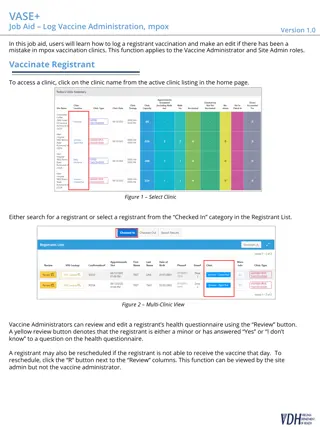Prevalence and Risk Factors of Chlamydia Trachomatis in Women Across Fiji Clinics
This study focuses on identifying the prevalence and risk factors of sexually transmitted Chlamydia trachomatis in women across rural and urban clinics in Fiji. It reveals a significant prevalence of the infection, with variations based on ethnicity, location, and age groups. The findings underscore the urgent public health issue of high Chlamydia prevalence in Fiji.
Download Presentation

Please find below an Image/Link to download the presentation.
The content on the website is provided AS IS for your information and personal use only. It may not be sold, licensed, or shared on other websites without obtaining consent from the author. Download presentation by click this link. If you encounter any issues during the download, it is possible that the publisher has removed the file from their server.
E N D
Presentation Transcript
IDENTIFYING PREVALENCE AND RISK FACTORS OF SEXUALLY TRANSMITTED CHLAMYDIA TRACHOMATIS IN WOMEN ACROSS CLINICS IN FIJI Isabella Auchus, MS3 University of California, San Francisco
BACKGROUND Chlamydia trachomatis: Most common bacterial sexually transmitted infection (STI) worldwide Fiji has some of the highest concentrations of STIs in the world. Complications of C. trachomatis: pelvic inflammatory disease, infertility, ectopic pregnancy, & adverse pregnancy outcomes. Location: Fiji is a part of the Western Pacific Island Countries and Territories. Viti Levu is Fiji s largest and most populated island (450,000 people) Viti Levu, Fiji Population: Most inhabitants of Viti Levu are Pacific Islanders. The majority are of iTaukei or Indo- Fijian ethnicity. Viti Levu Population Demographics iTaukei Indo-Fijian 36% Other Pacific Islander Other 7% 1% 56% Cells infected with Chlamydia
OBJECTIVE & METHODS Objective: To determine the prevalence and riskfactors for Chlamydia trachomatis STIs across rural and urban clinics and outreach sites in Viti Levu. Methods: Female population 18 Sites 6 Rural 12 Urban Data Collection Demographic/ Behavioral Questionnaire Vaginal swabs Red: Rural Black: Urban
RESULTS Prevalence of Chlamydia Chlamydia Prevalence by Ethnicity Overall: 18%(180/993) 30% Range across clinics: 0 to 38% (142/563) 25% High ( 15%) prevalence: 10 clinics (14/71) (13/77) 20% Prevalence by Location 15% Rural: 28%(22/79) 10% (13/282) Urban: 18%(160/914) 5% 2(1)=5.2, p<0.05 0% Prevalence by Age iTaukei Indo-Fijian Other Pacific Islander Other Women aged 18-25: 26% (69/268) 2(3)=53.5, p<0.001 Women aged 26-40: 15% (111/725) 2(1)=14.4, p<0.001
CONCLUSIONS & ACKNOWLEDGEMENTS High Chlamydia prevalence Dr. Deborah Dean High Risk UCSF Summer Explore Funding & National Institute of Allergy and Infectious Diseases grant R01 AI059647 iTaukei ethnicity Participants at rural clinics Mollie O Brien, Bethany Golden, Emily Lawson, Santha Muller, Maya Ladenheim, Dinora Murota, Kristy Dang, Sumeetha Swaminathan Participants 25 years Further analyses Dr. Kinisimere Nadredre, Dr. Mere Kurulo, Dr. Rachel Devi, Dr. Darshika Balak, Sr. Lice Kiti Cawaki, Shobleen Lal, Cilia Bukatatanoa, Seavula, Melania Ema, Rakaususu, Avikeshni Ranjeeta Vetaicini Palu Koroi, Selina Baleiyaro, Esiteri Tamata, Kelera Raikoso, Talice Cabemaiwai, Soko Covea Urgent public health issue


